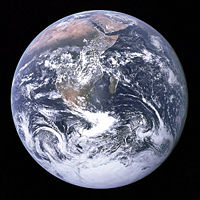Earth (planet): Difference between revisions
imported>John Stephenson m (→See also: bug bang link) |
imported>John Stephenson (Okay, fun's over - rewrote my own work...) |
||
| Line 1: | Line 1: | ||
{{subpages}} | {{subpages}} | ||
[[Image:Earth from Apollo 17.jpg|thumb|right|200px|Earth, as seen from space during the [[Apollo 17]] mission.<br>{{Earth from Apollo 17.jpg/credit}}]] | |||
[[Image:Earth from Apollo 17.jpg|thumb|right|200px|Earth, as seen from space during the [[Apollo 17]] mission.{{Earth from Apollo 17.jpg/credit}}]] | |||
'''Earth''' is the only place in the [[universe]] known to harbour [[life]]. It is the third [[planet]] out from its [[sun]]. Earth [[orbit]]s around 93 million [[mile]]s from the sun, within a region neither too hot nor too cold for its inhabitants to exist. In appearance, it is a blue-and-white little world, settled in a backwater region of the [[Milky Way]] [[galaxy]]. Its inhabitants have been described as "mostly harmless".<ref>Adams (1979).</ref> | '''Earth''' is the only place in the [[universe]] known to harbour [[life]]. It is the third [[planet]] out from its [[sun]]. Earth [[orbit]]s around 93 million [[mile]]s from the sun, within a region neither too hot nor too cold for its inhabitants to exist. In appearance, it is a blue-and-white little world, settled in a backwater region of the [[Milky Way]] [[galaxy]]. Its inhabitants have been described as "mostly harmless".<ref>Adams (1979).</ref> | ||
The accepted [[science|scientific]] view is that Earth and every other object in the [[solar system]] descend from a great cloud of interstellar [[gas]] and dust that condensed to form the sun about 4.6 billion [[year]]s ago. Life is known to have found a foothold only on Earth - more than 3.5 billions years ago - however, in recent years, researchers have made advances concerning potential habitats for life on other planets or their [[natural satellite|moon]]s. | |||
Earth is home to millions of [[species]], with [[human]]s dominant. They have survived and spread through exploiting Earth's resources, [[global warming|warming the Earth]] in the process. As a result, [[flooding]], [[drought]] and extreme [[weather]] seem to be more common today than in planet's recent past. | |||
==Footnotes== | ==Footnotes== | ||
{{reflist|2}} | |||
==References== | ==References== | ||
| Line 20: | Line 17: | ||
*[[Sun]] | *[[Sun]] | ||
*[[Galaxy]] | *[[Galaxy]] | ||
*[[Big Bang]] | |||
*[[Global warming]] | *[[Global warming]] | ||
Revision as of 01:18, 11 June 2008

(PD) Image courtesy of: Image Science & Analysis Laboratory, NASA Johnson Space Center
Earth is the only place in the universe known to harbour life. It is the third planet out from its sun. Earth orbits around 93 million miles from the sun, within a region neither too hot nor too cold for its inhabitants to exist. In appearance, it is a blue-and-white little world, settled in a backwater region of the Milky Way galaxy. Its inhabitants have been described as "mostly harmless".[1]
The accepted scientific view is that Earth and every other object in the solar system descend from a great cloud of interstellar gas and dust that condensed to form the sun about 4.6 billion years ago. Life is known to have found a foothold only on Earth - more than 3.5 billions years ago - however, in recent years, researchers have made advances concerning potential habitats for life on other planets or their moons.
Earth is home to millions of species, with humans dominant. They have survived and spread through exploiting Earth's resources, warming the Earth in the process. As a result, flooding, drought and extreme weather seem to be more common today than in planet's recent past.
Footnotes
- ↑ Adams (1979).
References
Adams, D. (1979) The Hitchiker's Guide to the Galaxy. London: Macmillan. ISBN 0330258648.